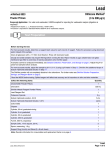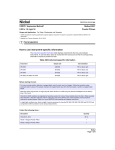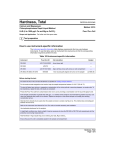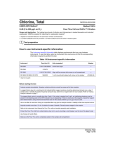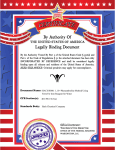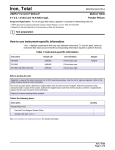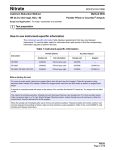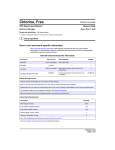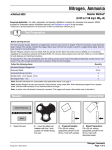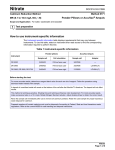Download Manual - Hach Cadmium Reagent Set
Transcript
Cadmium, 8017 Cadmium DOC316.53.01012 Dithizone Method1 Method 8017 (0.7 to 80.0 µg/L) Powder Pillows Scope and Application: For water and wastewater; digestion is required to determine total cadmium. 1 Adapted from Standard Methods for the Examination of Water and Wastewater (method 3500 Cd D). Test preparation How to use instrument-specific information The Instrument-specific information table displays requirements that may vary between instruments. To use this table, select an instrument then read across to find the corresponding information required to perform this test. Table 61 Instrument-specific information Instrument Sample cell Cell orientation DR 6000 2495402 Fill line faces right DR 5000 2495402 Fill line faces user DR 3900 2495402 Fill line faces user DR 3800, DR 2800, DR 2700 2495402 Fill line faces right Before starting the test: For more accurate results, determine a reagent blank value for each new lot of reagent. Follow the procedure using deionized water instead of the sample. Clean all glassware with 6 N Hydrochloric Acid Solution and rinse with deionized water. Sample cell orientation may vary. Refer to the instrument user manual for correct cell orientation. Cloudy and turbid samples may require filtering before running the test. Report results as µg/L soluble cadmium. Use glass membrane type filter to avoid loss of cadmium by adsorption onto the filter paper. If samples cannot be analyzed immediately, see Sample collection, preservation and storage. Adjust the pH of preserved samples before analysis. The Flow Cell and Sipper Modules cannot be used with this procedure. The DithiVer powder will not completely dissolve in the chloroform. For further notes see Dithiver solution preparation and storage. Read the MSDS before testing. Spilled reagent will affect test accuracy and is hazardous to skin and other materials. Goggles and gloves are recommended. In bright light conditions (e.g. direct sunlight) it may be necessary to close the cell compartment with the protective cover during measurements. Cadmium Page 1 of 8 Cadmium Collect the following items: Description Quantity Citrate buffer powder pillows 1 Chloroform 30 mL DithiVer Metals Reagent powder pillows 1 Potassium Cyanide 0.1 g Sodium Hydroxide solution, 50% 20 mL Cotton balls 1 Clippers 1 Cylinder, 25-mL graduated 1 Cylinder, 250-mL graduated 1 Cylinder, 50-mL graduated mixing 1 Funnel, 500-mL separatory 1 Sample Cells 2 Spoon, measuring, 0.1-g 1 Support ring (4-inch) and stand (5 x 8-inch base) 1 See Consumables and replacement items for reorder information. Dithizone method with powder pillows DANGER Cyanide is a deadly poison. Use a fume hood. Maintain cyanide solutions at pH 11 or greater to prevent formation of cyanide gas. Stored Programs 60 Cadmium, Dithizone Start 1. Select the test. Insert an adapter if required (see Instrumentspecific information). Refer to the user manual for orientation. Cadmium Page 2 of 8 2. Fill a 250-mL graduated cylinder to the 250-mL mark with sample. Pour the sample into a 500-mL separatory funnel. 3. Add the contents of one Buffer Powder Pillow for heavy metals, citrate type. Stopper the funnel and shake to dissolve. 4. DithiVer Solution Preparation: Add 30 mL of chloroform to a 50-mL mixing graduated cylinder. Add the contents of one DithiVer Metals Reagent Powder Pillow. Stopper the cylinder. Invert several times to mix. Cadmium Dithizone method with powder pillows (continued) 5. Add 20 mL of 50% Sodium Hydroxide Solution to the funnel. 6. Add a 0.1-g scoop of potassium cyanide to the funnel. Stopper. Shake vigorously for 15 seconds. 7. Remove the stopper. 9. Start the instrument timer. 10. Start the instrument timer and allow the funnel to stand undisturbed until the timer expires. 11. Prepared Sample: Insert a cotton plug the size of a pea into the delivery tube of the funnel and slowly drain the bottom (chloroform) layer into a dry 25-mL sample cell (the prepared sample). Stopper. Close the stopcock and shake the funnel vigorously during the 1-minute time period. The bottom (chloroform) layer will be orange to pink if cadmium is present. Start the instrument timer. A 1-minute reaction period will begin. 8. Add 30 mL of the DithiVer solution to the 500-mL separatory funnel. Stopper, invert, and open stopcock to vent. Close the stopcock and shake funnel once or twice; vent again. 12. Blank Preparation: Fill a dry sample cell with at least 10 mL of chloroform. Stopper. The cadmium-dithizone complex is stable for more than one hour if the sample cell is kept tightly capped and out of direct sunlight. Cadmium Page 3 of 8 Cadmium Dithizone method with powder pillows (continued) Zero 13. Insert the blank into the cell holder. 14. ZERO the instrument. The display will show: Read 15. Insert the prepared sample into the cell holder. 16. READ the results in µg/L cadmium. 0.0 µg/L Cd Interferences Table 62 Interfering substances Interfering substance Interference level Highly buffered samples or extreme sample pH May exceed the buffering capacity of the reagents and require sample pretreatment. Bismuth Greater than 80 mg/L. See treatment below. Copper Greater than 2 mg/L. See treatment below. Mercury All levels. See treatment below. Silver Greater than 2 mg/L. See treatment below. To eliminate interference from the metals listed in the Interfering substances table, insert the following steps into the procedure after step 4. 1. Measure approximately 5 mL of the DithiVer solution into the separatory funnel. Stopper the funnel, invert and open the stopcock to vent. Close the stopcock and shake the solution vigorously for 15 seconds. Allow the funnel to stand undisturbed until the layers separate (about 30 seconds). A yellow, red, or bronze color in the bottom (chloroform) layer confirms the presence of interfering metals. Draw off and collect the bottom (chloroform) layer for proper disposal. 2. Repeat the extraction with fresh 5-mL portions of the DithiVer solution (discarding the bottom layer each time) until the bottom layer shows a pure dark green color for three successive extracts. Extractions can be repeated several times without appreciably affecting the amount of cadmium in the sample. 3. Extract the solution with several 2- or 3-mL portions of pure chloroform to remove any remaining DithiVer, collecting the bottom layer each time for proper disposal. 4. Continue with step 5 of the procedure. 5. In step 8, substitute 28.5 mL of DithiVer solution for the 30 mL. 6. Continue with step 9 of the procedure. Cadmium Page 4 of 8 Cadmium Table 63 Substances that do not interfere Aluminum Lead Antimony Magnesium Arsenic Manganese Calcium Nickel Chromium Tin Cobalt Zinc Iron Sample collection, preservation and storage Collect samples in an acid-washed glass or plastic containers. Adjust the pH to 2 or less with nitric acid (about 2 mL per liter). Store preserved samples up to six months at room temperature. Adjust the pH to 2.5 with 5.0 N sodium hydroxide before analysis. Correct the test result for volume additions. Dithiver solution preparation and storage Store DithiVer Powder Pillows away from light and heat. A convenient way to prepare this solution is to add the contents of 16 DithiVer Metals Reagent Powder Pillows to a 500-mL bottle of chloroform and invert several times until well mixed (carrier powder may not dissolve completely). Store dithizone solution in an amber glass bottle. This solution is stable for 24 hours. Accuracy check Required for accuracy check: • Cadmium Voluette Ampule Standard, 25-mg/L Cd • TenSette® Pipet, 0.1–1.0 mL and tips 1. After reading test results, leave the sample cell (unspiked sample) in the instrument. 2. Select Options>More>Standard Additions from the instrument menu. 3. Accept the default values for standard concentration, sample volume, and spike volumes. After the values are accepted, the unspiked sample reading will appear in the top row. See the user manual for more information. 4. Open the standard solution ampule. 5. Use the TenSette Pipet to add 0.1 mL, 0.2 mL, and 0.3 mL of standard, respectively to three 250-mL samples and mix each thoroughly. 6. Follow the Dithizone method with powder pillows test procedure for each of the spiked samples, starting with the 0.1 mL sample spike. Measure each of the spiked samples in the instrument. 7. Select GRAPH to view the results. Select IDEAL LINE (or best-fit) to compare the standard addition results to the theoretical 100% recovery. Standard Solution Method Required for accuracy check: • Cadmium Standard Solution, 100-mg/L Cd. • Deionized water • 100-mL Volumetric flask Cadmium Page 5 of 8 Cadmium • Class A volumetric pipet and bulb 1. Prepare a 5.0-mg/L cadmium standard solution: a. Pipet 5.00 mL of Cadmium Standard Solution, 100-mg/L Cd, into a 100-mL volumetric flask. b. Dilute to the mark with deionized water. Prepare this solution daily. 2. Pipet 2.00 mL of the 5.0-mg/L Cadmium Standard Solution into 248 mL of deionized water in a 500-mL separatory funnel. This is a 40-µg/L cadmium solution. Perform Dithizone method with powder pillows on this solution beginning with step 3 of the procedure. 3. To adjust the calibration curve using the reading obtained with the standard solution, elect Options>More>Standard Adjust from the instrument menu. 4. Turn on the Standard Adjust feature and accept the shown concentration. If an alternate concentration is used, enter the concentration and adjust the curve to that value. Method performance Program Standard Precision 95% Confidence Limits of Distribution Sensitivity Concentration change per 0.010 Abs change 60 40.0 µg/L Cd 39.3–40.7 µg/L Cd 0.73 µg/L Summary of method The dithizone method is designed for the determination of cadmium in water and wastewater. The DithiVer Metals Reagent is a stable powder form of dithizone. Cadmium ions in basic solution react with dithizone to form a pink to red cadmium-dithizonate complex, which is extracted with chloroform. Test results are measured at 515 nm. Pollution prevention and waste management Both chloroform (D022) and cyanide (D003) solutions are regulated as hazardous wastes by the Federal RCRA. Do not pour these solutions down the drain. Chloroform solutions and the cotton plug used in the delivery tube of the separatory funnel should be collected for disposal with laboratory solvent waste. Collect the cyanide solution as a reactive waste. Be sure that cyanide solutions are stored in a caustic solution with a pH >11 to prevent potential release of hydrogen cyanide gas. See the current MSDS for disposal information. Consumables and replacement items Required reagents Description Cadmium Reagent Set Quantity/Test Unit Catalog number — 100/pkg 2242200 Includes:(1) 14202-99, (1) 14458-17, (1) 12616-99, (1) 767-14, (4) 2180-49, (1) 2572-01 Buffer Powder Pillows, citrate Chloroform, ACS DithiVer Metals Reagent Powder Pillows 1 100/pkg 40 mL 4L 1420299 1445817 1 100/pkg 1261699 Potassium Cyanide 0.1 g 125 g 76714 Sodium Hydroxide Solution, 50% 20 mL 500 mL 218049 Cadmium Page 6 of 8 Cadmium Required reagents (continued) Description Cotton Balls, absorbent Quantity/Test Unit Catalog number 1 100/pkg 257201 Quantity Unit Catalog number 96800 Required apparatus Description Clippers, for opening powder pillows 1 each Cylinder, graduated, 25-mL 1 each 50840 Cylinder, graduated, 250-mL 1 each 50846 Cylinder, graduated, mixing, 50-mL 1 each 189641 Funnel, separatory, 500-mL 1 each 52049 Sample cell, 25 mL square, matched pair with cap 2 2/pkg 2612602 Spoon, measuring, 0.1-g 1 each 51100 Support Ring, 4" 1 each 58001 Support Ring Stand, 5" x 8" base 1 each 56300 Recommended standards Description Unit Catalog number Cadmium Standard Solution, 100-mg/L Cd 100 mL 1402442 Chloroform, ACS 500 mL 1445849 Hydrochloric Acid Solution, 6.0 N 500 mL 88449 Sodium Hydroxide Standard Solution, 5.0 N 100 mL MDB 245032 Sodium Hydroxide Standard Solution, 5.0 N 59 mL SCDB 245026 4L 27256 Water, deionized Cadmium Page 7 of 8 Cadmium Optional reagents and apparatus Description Unit Cylinder, graduated, 5-mL each 50837 Filter Discs, glass, 47 mm 100/pkg 253000 Filter Holder, glass, for 47-mm filter each 234000 Flask, Erlenmeyer, 500-mL each 50549 Flask, filtering, 500-mL each 54649 Flask, volumetric, Class A, 100-mL each 1457442 Flask, volumetric, Class A, 250-mL each 1457446 Flask, volumetric, Class A, 1000-mL each 1457453 Gloves, chemical resistant, size 9 to 9.51 pair 2410104 Goggles, safety, vented each 2550700 Hot Plate, 3½-in. diameter, 120 VAC, 50/60 Hz each 1206701 pH Paper, pH 1.0 to 11.0 1 Catalog number 5 rolls/pkg 39133 Pipet Filler, safety bulb each 1465100 Pipet, serological, 2-mL each 53236 Pipet, TenSette®, 0.1 to 1.0 mL each 1970001 Pipet Tips, for TenSette Pipet 1970001 50/pkg 2185696 Pipet Tips, for TenSette Pipet 1970001 1000/pkg 2185628 Pipet, volumetric, 2.00-mL, Class A each 1451536 Pipet, volumetric, 3.00-mL, Class A each 1451503 Pipet, volumetric, 6.00-mL, Class A each 1451506 Pipet, volumetric, 8.00-mL, Class A each 1451508 Pipet, volumetric, 9.00-mL, Class A each 1451509 Pipet, volumetric, 10.00-mL, Class A each 1451538 Pipet, volumetric, 20.00-mL, Class A each 1451520 Tongs, crucible, 9-inch each 56900 Other sizes available. FOR TECHNICAL ASSISTANCE, PRICE INFORMATION AND ORDERING: In the U.S.A. – Call toll-free 800-227-4224 Outside the U.S.A. – Contact the HACH office or distributor serving you. On the Worldwide Web – www.hach.com; E-mail – [email protected] © Hach Company, 2007, 2010, 2012. All rights reserved. Printed in the U.S.A. HACH COMPANY WORLD HEADQUARTERS Telephone: (970) 669-3050 FAX: (970) 669-2932 Edition 7








